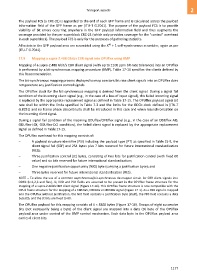Page 1187 - 5G Basics - Core Network Aspects
P. 1187
Transport aspects 2
The payload FCS (a CRC-32) is appended to the end of each GFP frame and is calculated across the payload
information field of the GFP frame as per [ITU-T G.7041]. The purpose of the payload FCS is to provide
visibility of bit errors occurring anywhere in the GFP payload information field and thus augments the
coverage provided by the per-superblock CRC-24 (which only provides coverage for the "control" overhead
in each superblock). The payload FCS is only for the purposes of gathering statistics.
43
All octets in the GFP payload area are scrambled using the X + 1 self-synchronous scrambler, again as per
[ITU-T G.7041].
17.9 Mapping a supra-2.488 Gbit/s CBR signal into OPUflex using BMP
Mapping of a supra-2.488 Gbit/s CBR client signal (with up to 100 ppm bit-rate tolerance) into an OPUflex
is performed by a bit-synchronous mapping procedure (BMP). Table 17-14 specifies the clients defined by
this Recommendation.
The bit-synchronous mapping process deployed to map constant bit rate client signals into an OPUflex does
not generate any justification control signals.
The OPUflex clock for the bit-synchronous mapping is derived from the client signal. During a signal fail
condition of the incoming client signal (e.g., in the case of a loss of input signal), this failed incoming signal
is replaced by the appropriate replacement signal as defined in Table 17-15. The OPUflex payload signal bit
rate shall be within the limits specified in Table 7-3 and the limits for the ODCb clock defined in [ITU-T
G.8251] and no frame phase discontinuity shall be introduced in this case and when resynchronization on
the incoming client signal.
During a signal fail condition of the incoming ODUflex/OPUflex signal (e.g., in the case of an ODUflex-AIS,
ODUflex-LCK, ODUflex-OCI condition), the failed client signal is replaced by the appropriate replacement
signal as defined in Table 17-15.
The OPUflex overhead for this mapping consists of:
– A payload structure identifier (PSI) including the payload type (PT) as specified in Table 15-9, the
client signal fail (CSF) and 254 bytes plus 7 bits reserved for future international standardization
(RES);
– Three justification control (JC) bytes, consisting of two bits for justification control (with fixed 00
value) and six bits reserved for future international standardization;
– One negative justification opportunity (NJO) byte (carrying a justification byte); and
– Three bytes reserved for future international standardization (RES).
NOTE – To allow the use of a common asynchronous/bit-synchronous de-mapper circuit for CBR client signals into
ODUk (k=1,2,3 and flex), JC, NJO and PJO fields are assumed to be present in the OPUflex frame structure for the
mapping of a supra-2.488G CBR client signal (Figure 17-18). This OPUflex frame structure is now compatible with the
OPUk frame structure for the mapping of a CBR2G5, CBR10G or CBR40G signal (Figure 17-1). As a CBR signal is mapped
into the OPUflex without justification, the NJO field contains a justification byte (stuff), the PJO field contains a data
byte (D), and the JC bits are fixed to 00.
The OPUflex payload for this mapping consists of 4 3808 bytes (Figure 17-18). Groups of eight successive
bits (not necessarily being a byte) of the client signal are mapped into a data (D) byte of the OPUflex
payload area under control of the BMP control mechanism. Each data byte in the OPUflex payload area
carries 8 client bits.
1177

